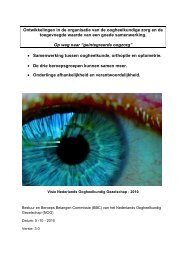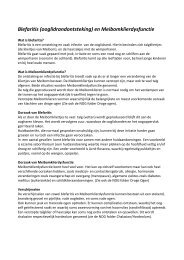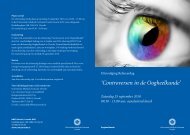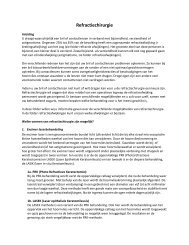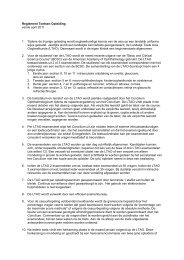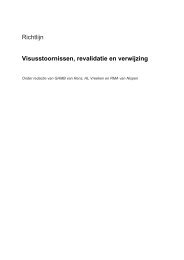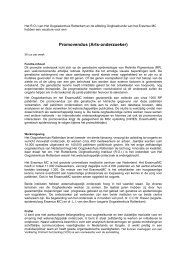terminology and guidelines for glaucoma ii - Kwaliteitskoepel
terminology and guidelines for glaucoma ii - Kwaliteitskoepel
terminology and guidelines for glaucoma ii - Kwaliteitskoepel
You also want an ePaper? Increase the reach of your titles
YUMPU automatically turns print PDFs into web optimized ePapers that Google loves.
In general, the goal of <strong>glaucoma</strong> treatment can be summarized as follows: preservation<br />
of visual function adequate to the individual needs with minimal or no side effects, <strong>for</strong><br />
the expected lifetime of the patient, without any disruption of his/her normal activities,<br />
at a sustainable cost.<br />
B. Suggested ways to obtain the goal (see Ch. 3 <strong>and</strong> 4)<br />
B.1.<br />
B.1.1.<br />
B.1.2.<br />
B.1.3.<br />
Selection of patients to be treated<br />
Identification of patients with disease<br />
Identification of patients at risk of developing the disease<br />
Treatment of the above when actual or expected rate of decay is likely to interfere with quality of life<br />
B.2. Decreasing the risk of ganglion cell loss<br />
B.2.1. Determine the target IOP <strong>for</strong> the individual<br />
In general, when there is more advanced damage, lower IOPs are needed to prevent decrease in quality<br />
of life<br />
B.2.2. IOP lowering<br />
B.2.2.1. Drugs<br />
Verify the short term effect on the stated endpoint in each individual i.e. IOP, blood flow etc. Confirm<br />
such effect in long term. When not effective, withdraw <strong>and</strong> substitute be<strong>for</strong>e adding a further drug<br />
Avoid combining drugs aimed at the same or similarly acting receptors<br />
Consider drug combinations which combine additive, different mechanism<br />
B.2.2.2. Surgery<br />
Compared with pharmacological treatment, surgery to achieves <strong>and</strong> maintains lower IOPs, with less<br />
diurnal variations, regardless of pre-treatment levels. Primary surgery, supported by large prospective<br />
studies, should be considered in selected individuals <strong>and</strong>/or specific environments<br />
B.2.2.3. Laser<br />
Verify the short term effect on the stated target IOP in each individual<br />
Confirm the above effect in long term<br />
When not effective, proceed to the next step to achieve the target IOP<br />
B.2.2.4. Verify the target IOP <strong>and</strong> the trends in the visual fields/disc.<br />
B.2.3. Enhancement of optic nerve blood flow (Ch. 1.5)<br />
B.2.4. Neuroprotection, neurorescue, neuroregeneration<br />
B.3.<br />
Incorporation of a quality of life measure in the outcome of treatment<br />
C. On-going quality control with independent evaluation of efficacy, safety, cost<br />
C.1.<br />
Failures include patients suffering from the consequences of insufficient IOP lowering, unnecessary<br />
treatment, surgical complications, <strong>and</strong> progression of disease.<br />
Ch. Intro 2 EGS



